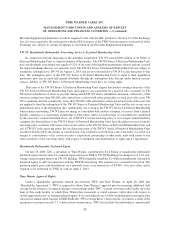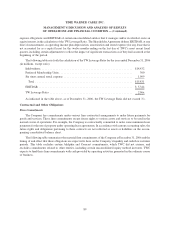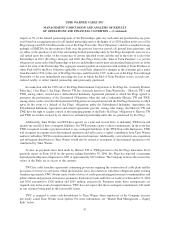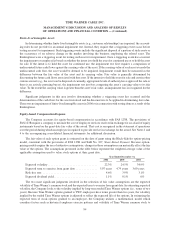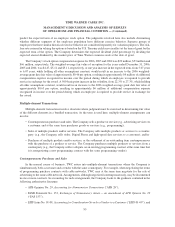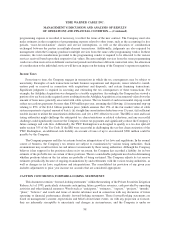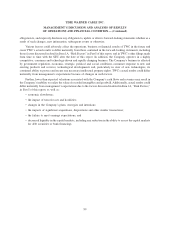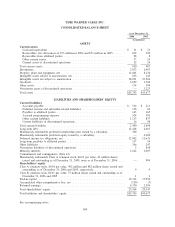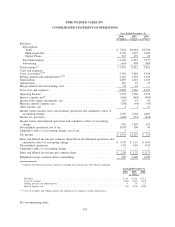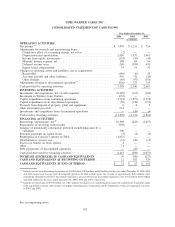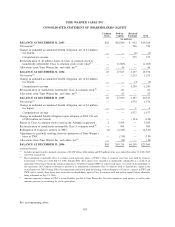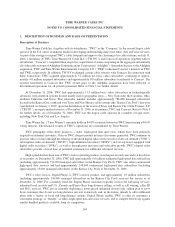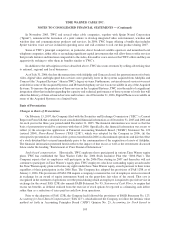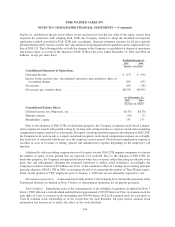Time Warner Cable 2006 Annual Report Download - page 101
Download and view the complete annual report
Please find page 101 of the 2006 Time Warner Cable annual report below. You can navigate through the pages in the report by either clicking on the pages listed below, or by using the keyword search tool below to find specific information within the annual report.• EITF Issue No. 02-16, Accounting by a Customer (Including a Reseller) for Certain Consideration Received
from a Vendor (“EITF 02-16”).
The Company’s policy for accounting for each transaction negotiated contemporaneously is to record each
element of the transaction based on the respective estimated fair values of the products or services purchased and the
products or services sold. The judgments made in determining fair value in such arrangements impact the amount
and period in which revenues, expenses and net income are recognized over the term of the contract. In determining
the fair value of the respective elements, TWC refers to quoted market prices (where available), historical
transactions or comparable cash transactions. The most frequent transactions of this type that the Company
encounters involve funds received from its vendors, which the Company accounts for in accordance with EITF
02-16. The Company records cash consideration received from a vendor as a reduction in the price of the vendor’s
product unless (i) the consideration is for the reimbursement of a specific, incremental, identifiable cost incurred in
which case it would record the cash consideration received as a reduction in such cost or (ii) the Company is
providing an identifiable benefit in exchange for the consideration in which case it recognizes revenue for this
element.
With respect to programming vendor advertising arrangements being negotiated simultaneously with the same
cable network, TWC assesses whether each piece of the arrangements is at fair value. The factors that are
considered in determining the individual fair values of the programming and advertising vary from arrangement to
arrangement and include:
• existence of a “most-favored-nation” clause or comparable assurances as to fair market value with respect to
programming;
• comparison to fees under a prior contract;
• comparison to fees paid for similar networks; and
• comparison to advertising rates paid by other advertisers on the Company’s systems.
Advertising revenues associated with such arrangements were less than $1 million for each of the years ended
December 31, 2006 and 2005, and were $9 million in 2004.
Sales of Multiple Products or Services
The Company’s policy for revenue recognition in instances where multiple deliverables are sold contempo-
raneously to the same counterparty is in accordance with EITF Issue No. 00-21, Revenue Arrangements with
Multiple Deliverables, and SEC Staff Accounting Bulletin No. 104, Revenue Recognition. Specifically, if the
Company enters into sales contracts for the sale of multiple products or services, then the Company evaluates
whether it has objective fair value evidence for each deliverable in the transaction. If the Company has objective fair
value evidence for each deliverable of the transaction, then it accounts for each deliverable in the transaction
separately, based on the relevant revenue recognition accounting policies. However, if the Company is unable to
determine objective fair value for one or more undelivered elements of the transaction, the Company recognizes
revenue on a straight-line basis over the term of the agreement. For example, the Company sells cable, Digital
Phone and high-speed data services to subscribers in a bundled package at a rate lower than if the subscriber
purchases each product on an individual basis. Subscription revenues received from such subscribers are allocated
to each product in a pro-rata manner based on the fair value of each of the respective services.
Purchases of Multiple Products or Services
The Company’s policy for cost recognition in instances where multiple products or services are purchased
contemporaneously from the same counterparty is consistent with the Company’s policy for the sale of multiple
deliverables to a customer. Specifically, if the Company enters into a contract for the purchase of multiple products
96
TIME WARNER CABLE INC.
MANAGEMENT’S DISCUSSION AND ANALYSIS OF RESULTS
OF OPERATIONS AND FINANCIAL CONDITION — (Continued)




